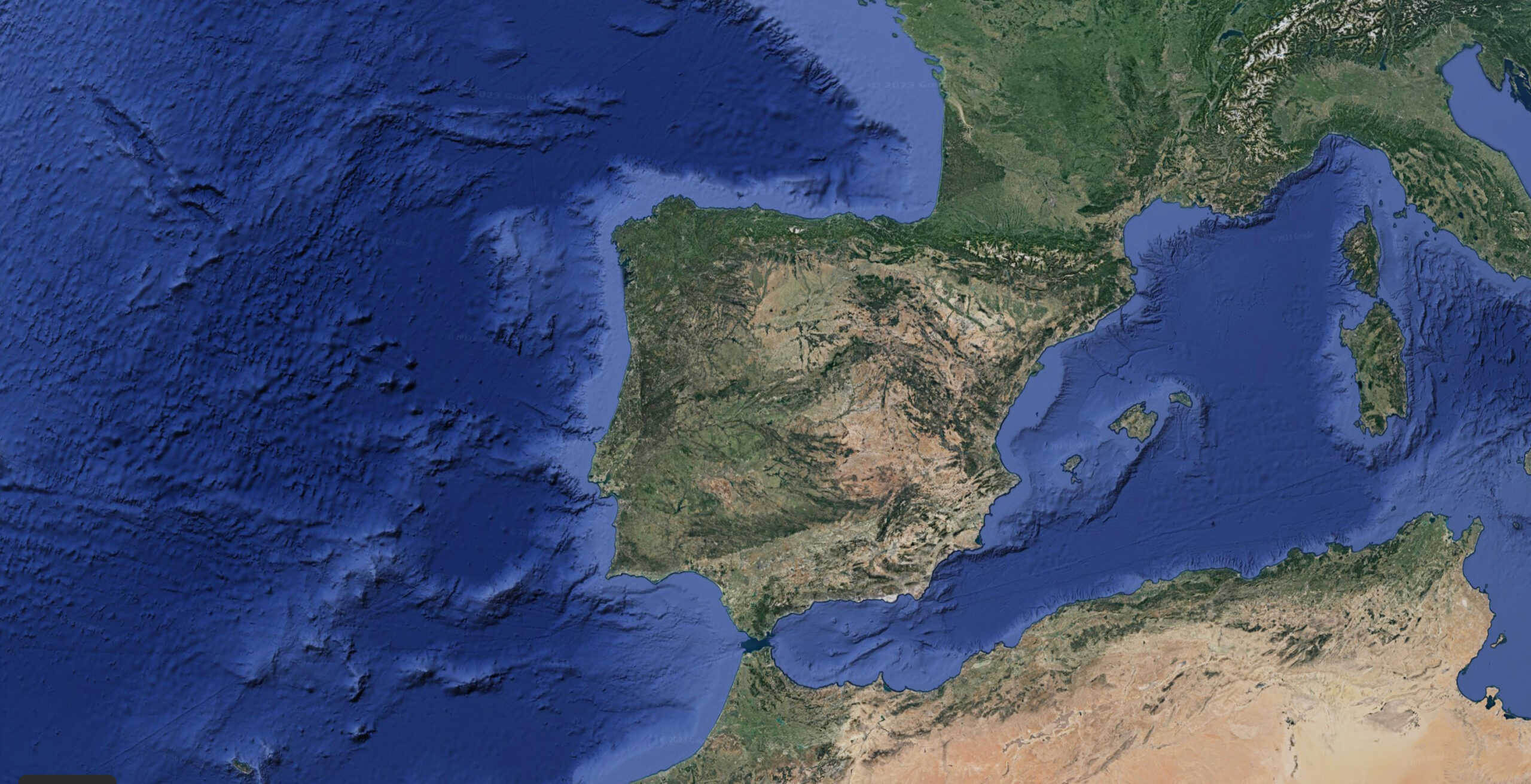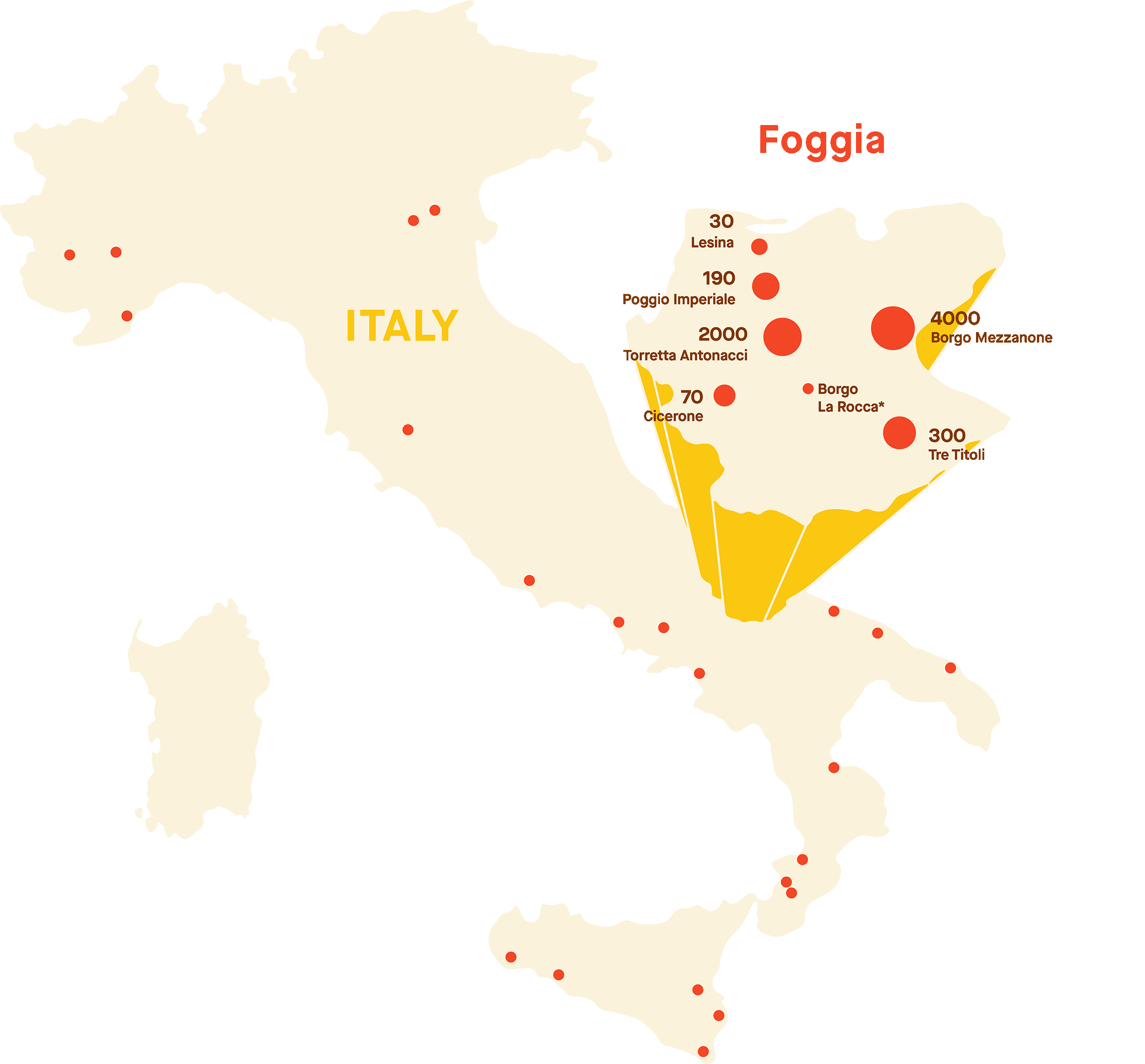
Under the blistering summer sun, with temperatures that often exceed 40°C, they pick fruits and vegetables to fill European supermarket shelves.
But how are increasingly hot summers impacting the lives of migrant workers in Spain and Italy's greenhouse farms?

By Claudia Colliva, Giada Santana and Sofía Álvarez Jurado
Published: 31 July 2023
The names of the workers in this story have been changed for their protection
On a warm Monday morning in early June, a young man waits shyly as a truck refills three large blue water tanks. They’re his only source of clean drinking water, so it’s important to be first in line. He’s holding a big plastic flask, which he rushes to fill to the brim as soon as the truck is gone. Struggling under the weight of the next two days’ water supply, he heads back home, to one of the hundreds of slums in Borgo Mezzanone, the most populous shanty town in Europe.
Located in the southern Italian province of Foggia, Borgo Mezzanone is home to between 2,000 and 4,000 (depending on the time of year) men and women with migrant backgrounds. Most of them are agricultural workers, earning a living on one of the many fields that extend around the camp. Some live in the settlement year round, while others rent a shack for the summer months due to the season’s high demand for agricultural workers. Under the blistering Italian sun, with temperatures that often exceed 40°C, they pick fruits and vegetables to fill Italian and European supermarket shelves.
Puglia, where Foggia is located, is the Italian region with the largest number of agricultural companies—almost 200 thousand—and like in most of Italy, the vast majority are small, family-run businesses. In 2022, the region’s agriculture had an output of nearly 4.5 billion euros. Meanwhile, residents of Borgo Mezzanone were being paid between three and five euros per hour for their labour.
Despite the scorching temperatures, their employers don’t provide drinking water or shaded areas to rest. Breaks, in any case, are a luxury they are often not afforded—no matter how physically exerting their work. Many don’t have contracts or even residence permits, leaving them even more vulnerable to exploitation. Each year, at least a few workers head out into the fields, and don’t make it back alive.

“Each year, at least a few workers head out into the fields, and don’t make it back alive.”
Surviving the Italian summer
Just after the water truck has done its rounds, the residents of Borgo Mezzanone start trickling towards the tanks. They are all carrying plastic jerrycans ready to be filled. One man has several empty ones piled up in a squeaking shopping trolley, another is pushing a single large one in a baby stroller. All around, an array of shacks made of corrugated metal sheets, tarpaulin and slabs of cement compose the improvised settlement. When the sun is out in summer, these improvised homes heat up like ovens, making them uninhabitable. There are six water tanks throughout the settlement, and each holds 100,000 litres of water. Some residents say the refill truck comes around twice per week. Its driver, however, insists he makes the journey to the settlement every other day to deliver water. Typically, the refills are enough to sustain the residents, but supplies can run short once the summer heat strikes.
Besides the many stray cats and dogs, the streets aren’t especially crowded. It’s 11 in the morning and most people are out working. They won’t be back until the mid to late afternoon. Piles of trash poison the air with a pungent smell. In the distance, the sound of a prayer call erupts from the speakers of a local mosque. The deep, melodic voice travelling through the camp belongs to Hakim, a long-time resident of Borgo Mezzanone and a leader in the community.
“Working in agriculture here is like being on a battlefield,” he says. Hakim is from Tema, the largest port city in Ghana. The 48-year-old has kind eyes and a welcoming smile. Sitting in the shade of a local bar owned by a fellow Ghanaian resident of Borgo, his calloused hands resting on the table before him, he looks resigned.
Hakim worked on and off on tomato farms while living in Borgo Mezzanone for eight years. Almost none of the workers have contracts, he explains. “We are not asking for contracts because it won’t yield anything,” he says. “Even if they give you a contract for 30 days, they only give you three working days in your pay slip, which is bullshit.” The tomato harvest only lasts a couple of months, at the height of summer, and workers are often paid based on how many crates they can fill rather than how many hours they work. So they push themselves as hard as possible, Hakim says, and suffer the consequences of the damage done to their bodies later.



Figure 1: 2021 Populations of migrant workers living in informal settlements in Foggia.
More than 6,000 migrants live in informal settlements in the province of Foggia alone. In Italy there are at least 10,000 residents scattered across 150 informal settlements.
*No data for Borgo La Rocca was recorded in 2021
Last year, a local doctor reported a case of such severe dehydration that the worker in question lacked fluid in their bones. Other migrant workers develop cardiovascular or respiratory conditions. Khady Sene, a representative of the local Caritas branch, devotes most of her time trying to help migrant workers out of irregular working conditions. According to her, countless people approach her organisation with health issues each year after the harvest season—ranging from chronic back pain to muscle damage.
Because no aggregated data exists on the health of agricultural workers (migrant and otherwise) in Italy, it is hard to quantify the extent of the damage caused by their working and living conditions, especially the long-term effects of extended exposure to extreme heat. A study carried out by the Italian Labour Inspectorate’s Worklimate Project, however, revealed a direct correlation between high temperatures and an increase in workplace accidents in the Italian agricultural sector. The research team also found that working at certain temperatures has serious health consequences, emphasising the importance of hydration and breaks to prevent serious harm. Agricultural workers, especially those of migrant origin, however, rarely have access to either.
Hakim remembers that 15 people died of heat strokes in the fields of Puglia in the summer of 2015. A local doctor confirmed two similar deaths in the Foggia province alone in the summer of 2022. According to FLAI-CGIL, Italy’s largest trade union of agricultural workers, there were at least five in the country. The trade union does its best to keep track of the working conditions of undocumented migrants and uncontracted workers so it can denounce abuses. But even for unionists it sometimes proves difficult to monitor what happens in a sector where illegal work practices are so endemic. When victims are undocumented workers, accidents, even fatal ones, are exponentially more likely to go unreported.




Life between a field and a metal container
“It’s very warm here,” says Hakim. “It’s very, very hot. It’s just like in the desert in Africa.” He pauses. “And a lot of our houses are made of metal. It’s impossible to live here.” Only one home in Borgo Mezzanone has air conditioning. That is, according to its owner, who takes great pride in his possession. The air conditioner is rusty and clearly missing a few important components, but it keeps Moussa’s home a couple of degrees cooler than those of his neighbours. “All the others can’t stay inside in the summer,” he says.
Moussa emigrated to Italy from Mali in 2008 and has spent the past 15 years in Borgo Mezzanone. He’s in his mid-thirties, and up until last summer, he often worked on grape farms. According to the law, his shifts should not have gone over 6 hours and 40 minutes—but he often had to work longer to finish harvesting rows of grapes. Many companies encourage workers to stay overtime, even if it means working during the hottest hours of the day, with no shade to offer some meagre respite from the sun, says Moussa.
Italian labour law requires that employers evaluate the health risks, including meteorological ones, that their workers might be exposed to, and implement appropriate preventive measures. Despite this, the only water Moussa and his colleagues had access to on-site was whatever they could bring with them in their own water bottles. This is common practice in the fields of Puglia, just as it’s common practice for workers not to have scheduled breaks. “For Italians yes, but not for Africans,” says Moussa, quoting what he was told by his employer.
As dire as their situation might be, people like Moussa and Hakim—and generally all those living in Borgo Mezzanone—have a leg up among the thousands of immigrant workers residing in informal settlements in Southern Europe. In Italy, around 10,000 men and women live inside an informal settlement. Among these, over 7,000 reside in the region of Puglia. Borgo Mezzanone residents, at the very least, have access to water, electricity and basic sanitary services. There are, however, at least 150 informal settlements in Italy, and the majority are not nearly as well equipped. Less than half of the settlements have clean drinking water or electricity. Only about a quarter have toilets. Jean-René Bilongo, president of the FLAI-CGIL Agromafia Observatory, defines Borgo Mezzanone as a “three-star hotel” compared to the other settlements. And while that paints a complicated picture of Italy, other European countries present parallel scenarios.
Suffocating under Spain’s plastic sea
In Spain, in the regions of Andalucía, Castilla la Mancha and Murcia, over 6,000 people live in informal settlements similar to those found in Italy. More than half are in Almería, the province that employs the highest number of people in the agricultural sector—25% of the population, compared to a national average of around 4%. In the settlement of Atochares, one of the largest in the area, many residents know of Borgo Mezzanone. Some even have friends there. Unlike those friends, however, the only water available to them is contaminated. Their access is limited to what can be extracted from four wells dug by the residents themselves.
Although the water isn’t safe to drink, lines of people accumulate every day, like in Borgo, to fill large plastic containers—many of which used to store pesticides. They then boil the water and use it for washing, cooking and cleaning their homes, putting their health at risk. To drink, they have to buy bottled water.
Karim, 24 years old, originally from the Moroccan town of Beni Mellal, is one of the residents of Atochares. Following a treacherous crossing of the Mediterranean on a skiff, he disembarked in Sicily in 2009 aged 10. After a few years living in Naples, he smuggled himself into Spain by hiding inside a truck. Now, he’s looking for ways to bring his younger brother over from Morocco as well. Karim is talkative and friendly. He shares his small shack in Atochares with his friend Nur, also from Morocco. He just got his driver’s licence, although he admits he still struggles to parallel park. And, like most of the 78,000 people of migrant origin working in Almería’s agricultural sector, he works in a nearby greenhouse.
“The only water available to them is contaminated. Their access is limited to what can be extracted from four wells dug by the residents themselves.”




Almería boasts around 32,554 hectares of greenhouses. Drone footage of the province’s landscape, or even a quick search on Google Earth, will showcase an expanse of white roofing so staggeringly vast that the area has become known as the “mar de plástico” (the plastic sea). A 2017 study conducted inside one such greenhouse recorded an atmospheric temperature of 55 degrees Celsius in August.
Samba, a 46-year-old Senegalese worker with 20 years of experience in the region’s greenhouses, says that the heat becomes unbearable as early as 10:30 in the morning when temperatures rise in the spring and summer months. “Every summer I hear that at least one person dies from the heat inside the greenhouses,” he says. Last year, he witnessed one of his colleagues, Farid, collapse in the greenhouse. He was the one who rescued him: fanned him and gave him water. Farid recovered, but he broke his hip in the fall and now lives—and works—in constant pain.
Just like in Puglia, all the testimonies gathered attest that employers do not provide water to greenhouse workers like Samba, Farid and Karim, although Spanish law dictates that they should. And just like in Italy, no aggregated data exists on the health of agricultural workers in Spain. However, a study by Fernando Plaza, a professor at the University of Almería and former nurse, proved that many patients seeking treatment due to alleged domestic and traffic accidents were in fact involved in work-related incidents. For migrants working off the books, telling the truth often means losing their job, so work-related incidents and illnesses go unreported and sometimes untreated.
Samba and Farid at least have legal residence permits, which enables them to leave Spain freely to visit their families, as well as openly denounce workplace injustices. Karim still doesn’t, but he does finally have a work contract, which will eventually enable him to apply to be regularised. He works seven days a week, 8 hours a day, for 6 euros per hour. Despite the fact that the legal minimum wage in Spain is 8.28 euros, he considers himself lucky. Most people in Atochares earn less. For people like him, who don’t have a work or residence permit, it is common to have to pay their employer to be given a contract. “But not my boss,” says Karim, holding the key to his regularisation: an envelope with all of his payslips.
Can you spot the “Mar de plástico” on the south coast of Spain?





The agricultural powerhouses of Europe
Italy and Spain rank first and third in Europe in terms of the added value of their agriculture. In 2022, Puglia’s agriculture had a total output of nearly 4.5 billion euros. Almería, on the other hand, exported 2.86 tonnes of fruit and vegetables during the 2021/2022 harvest season, worth a total of 3.7 billion euros. Both Puglia and Almería—as well as Spain and Italy more generally—export their produce throughout the entire continent.
“What if we weren’t here,” asks Samba. “How would they bring produce to Germany, France, and elsewhere?” From Berlin to Paris, Brussels to Amsterdam, supermarket shelves are stacked with fruits and vegetables picked by people like him. Like Hakim, Moussa and Karim. Despite how integral their work is to the Italian and Spanish economies, and how indispensable to European consumers, employees like them—on the lowest rung of the agricultural supply chain—continue to work and live in inhumane conditions, in total violation of both national and EU regulations.
Accountability, or lack thereof
The European Union is currently negotiating a corporate due diligence directive that aims to prosecute human rights violations, as well as environmental damages. The text proposed by the European Commission seeks to make companies operating in the EU legally responsible for activities throughout their entire value chain, thus adding a much-needed layer of accountability to global supply chains. On 1 June of this year, the directive received the green light from the EU Parliament. Discussions continue, with the Council expected to chime in on the proposition soon.
At a national level, Italy’s EU-funded Recovery and Resistance Plan (PNRR), which consists of a record 68.9 billion euros in grants and 122.6 euros billion in loans to help the country build a more sustainable future, also comprises 200 million euros for the dismantling of Italy’s informal settlements. Of the total, 53 million is for Borgo Mezzanone alone. Local municipalities will need to present detailed plans outlining how they intend to use the money to build an alternative to the settlements before the funds are given the green light.
The municipality of Manfredonia, in charge of Borgo Mezzanone, has been engaged in conversations with local organisations and residents of the settlement to devise a viable project, which was presented on 30 June. Khady Sene from Caritas, a leading voice in these negotiations, is weary but optimistic about the settlement’s future prospects. Hakim, who also participated in some of the meetings, is much more sceptical. “This is something that we’ve been pressing for for such a long time,” he says. “So how can we trust that if they have been given 53 million, they are going to use even just one euro to do something for us?”
In Almería, the eviction of a neighbouring settlement to Atochares—El Walili—had tragic consequences in January this year. Hundreds of people lost their homes and, because authorities didn’t offer alternative living quarters, had to resettle in other, already overcrowded informal settlements. The events received broad national coverage in Spain, and the mayor of Níjar, in charge of both El Walili and Atochares, promised that future evictions of the remaining settlements wouldn’t be carried out this same way. It remains to be seen what will happen now that a right-wing coalition with a stark anti-immigration agenda won the regional elections last June.




“How can we trust that if they have been given 53 million, they are going to use even just one euro to do something for us.”
Generational hope
Until structural change is enacted, the future remains uncertain for three generations of agricultural workers. The youngest of them all, Karim, 24, imagines a future in Spain but dreams of the day he will return to Beni Mellal to visit his mother. Just like last time he was able to go. “I took a plane to Casablanca,” he recalls. “She was in the kitchen. I called her on the phone and she told me she missed me a lot, and I answered: look, I am behind you right now.” When he has his residence permit, he’ll be able to surprise her more often.
Moussa, 35, has finally found a stable job in northern Italy and now shares a house with a couple of friends. When he returns to Foggia for a weekend to collect some belongings he left behind, he seems like a different person. Sitting in the passenger seat of his friend’s car on the way to Borgo, he cranks up the music and dances the entire time. Looking out the window at the fields rolling past—the same ones he used to work on—he proclaims: “Dear Foggia, you never change.” His voice, though wistful, carries a note of sadness.
For his part, Samba, 46, is content knowing that his daughters, having grown up in Spain, will have a better future than the one the country has granted him, and is not contemplating returning to Senegal. He can’t imagine taking them away from the only home they’ve ever known. Hakim, the oldest of the four at 48, momentarily loses his stoicism when he thinks of leaving Italy and returning to Tema, his hometown in Ghana. His voice trembles lightly with suppressed emotion as he talks of the port where he grew up, of his mother’s fish stall, of his siblings. “Go back?” he asks. “Yes, why not. Maybe someday.”

This article was developed with the support of Journalismfund.eu
With additional support from the IJ4EU fund
Published by
Are We Europe
Research, reporting & photography
Claudia Colliva, Giada Santana
and Sofía Álvarez Jurado
Editor
Juli Simond
Editor-in-chief
Anneleen Ophoff
Creative direction, layout & illustration
Eddie Stok
Infographic design
Hayden Pegues








